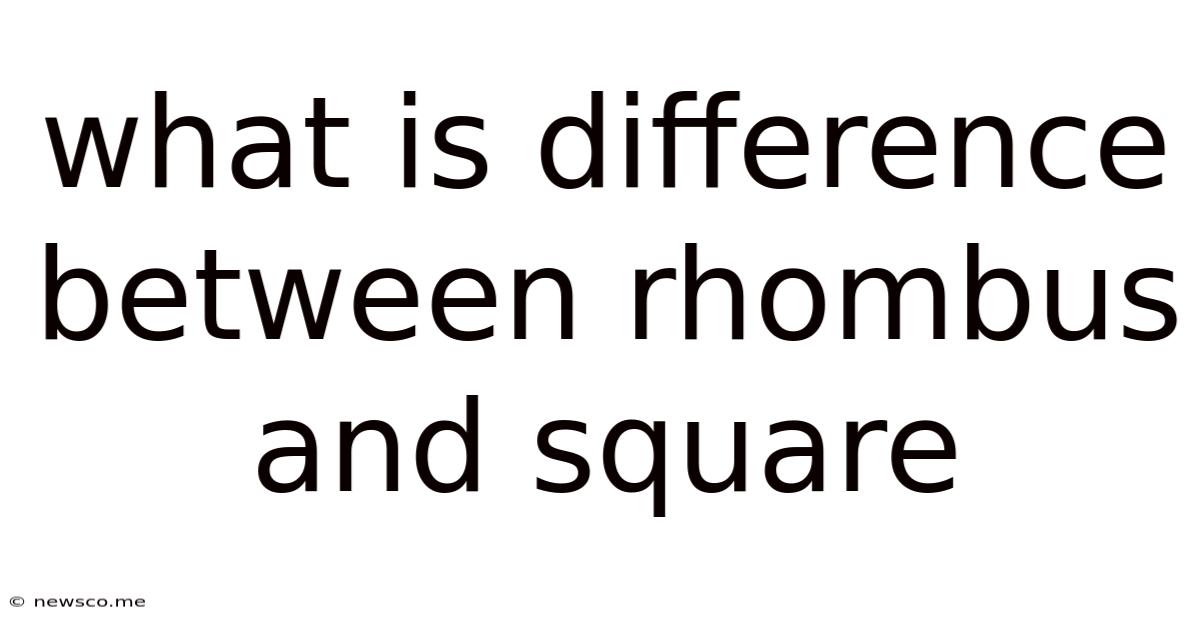What Is Difference Between Rhombus And Square
News Co
Mar 20, 2025 · 4 min read

Table of Contents
What's the Difference Between a Rhombus and a Square? A Deep Dive into Quadrilaterals
Understanding the differences between geometric shapes is fundamental to grasping mathematical concepts. While both rhombuses and squares belong to the broader category of quadrilaterals (four-sided polygons), they possess distinct properties that set them apart. This article delves into the intricacies of rhombuses and squares, highlighting their similarities and, more importantly, their key differences. We'll explore their defining characteristics, explore their relationships within the broader family of quadrilaterals, and provide practical examples to solidify your understanding.
Defining Characteristics: Rhombus
A rhombus is a quadrilateral characterized by four equal sides. This is its defining feature. However, it's crucial to note that equal sides alone don't define a rhombus; its angles also play a vital role. Let's examine the key characteristics:
Key Properties of a Rhombus:
- Four equal sides: This is the most prominent characteristic. All four sides have the same length.
- Opposite sides are parallel: Like all parallelograms (a larger family of quadrilaterals to which rhombuses belong), opposite sides of a rhombus are parallel to each other.
- Opposite angles are equal: The angles opposite each other within the rhombus are congruent (have the same measure).
- Consecutive angles are supplementary: Any two angles that share a side add up to 180 degrees.
- Diagonals bisect each other at right angles: The lines connecting opposite corners (diagonals) intersect each other at a 90-degree angle, and each diagonal is bisected (cut in half).
- Diagonals bisect the angles: Each diagonal divides its corresponding angles into two equal angles.
Defining Characteristics: Square
A square is a more specialized quadrilateral. It inherits many properties from the rhombus but adds a crucial element: right angles.
Key Properties of a Square:
- Four equal sides: Like a rhombus, a square has four sides of equal length.
- Four right angles (90°): This is the key differentiator between a rhombus and a square. All four interior angles measure 90 degrees.
- Opposite sides are parallel: As with rhombuses, opposite sides are parallel.
- Diagonals bisect each other at right angles: The diagonals intersect at a 90-degree angle and bisect each other.
- Diagonals are equal in length: Unlike a rhombus (except for special cases like a square!), the diagonals of a square are equal in length.
The Key Difference: Angles
The fundamental difference between a rhombus and a square lies in their interior angles. A rhombus can have angles of varying measures, as long as opposite angles are equal and consecutive angles are supplementary. A square, on the other hand, is rigidly defined by its four 90-degree angles. This makes a square a special type of rhombus – a rhombus with right angles.
Visualizing the Difference
Imagine two quadrilaterals:
- Quadrilateral A: Four sides of equal length, but angles that are not all 90 degrees. This is a rhombus. It might be squished or stretched, but its sides remain equal.
- Quadrilateral B: Four sides of equal length, and all four angles measure 90 degrees. This is a square. It's a perfectly symmetrical and regular quadrilateral.
Rhombus vs. Square: A Comparison Table
| Feature | Rhombus | Square |
|---|---|---|
| Sides | Four equal sides | Four equal sides |
| Angles | Opposite angles equal, consecutive angles supplementary (not necessarily 90°) | Four right angles (90°) |
| Diagonals | Bisect each other at right angles | Bisect each other at right angles, equal in length |
| Parallel Sides | Opposite sides parallel | Opposite sides parallel |
| Symmetry | Rotational symmetry of order 2 | Rotational symmetry of order 4 |
| Special Case | Square is a special case of a rhombus | - |
Relationship within Quadrilateral Family
Understanding the relationship between rhombuses and squares requires looking at the broader family of quadrilaterals. Here's a hierarchical view:
- Quadrilaterals: The broadest category encompassing all four-sided polygons.
- Parallelograms: A subset of quadrilaterals where opposite sides are parallel.
- Rectangles: Parallelograms with four right angles.
- Rhombuses: Parallelograms with four equal sides.
- Squares: Parallelograms with four equal sides and four right angles (a special case of both rhombuses and rectangles).
Real-World Examples
While you might not encounter perfect geometric shapes in everyday life, the principles of rhombuses and squares are evident in many objects:
- Rhombus: The shapes of some crystals, certain kite designs, and some tiles in floor patterns can approximate a rhombus. The faces of certain gemstones often exhibit rhombic forms.
- Square: Window panes, floor tiles, tabletops, and many everyday objects are designed with square shapes for stability and aesthetic reasons.
Conclusion
The difference between a rhombus and a square boils down to the measure of their interior angles. A rhombus is a quadrilateral with four equal sides, while a square is a rhombus with the added constraint of four 90-degree angles. Understanding these distinctions is vital for anyone studying geometry or working with shapes in any applied field. While a square is a special type of rhombus, remember that not all rhombuses are squares. This nuanced understanding is key to mastering geometric concepts. By grasping the unique properties of each shape and understanding their hierarchical relationship within the family of quadrilaterals, you can confidently differentiate between these important geometric figures.
Latest Posts
Related Post
Thank you for visiting our website which covers about What Is Difference Between Rhombus And Square . We hope the information provided has been useful to you. Feel free to contact us if you have any questions or need further assistance. See you next time and don't miss to bookmark.